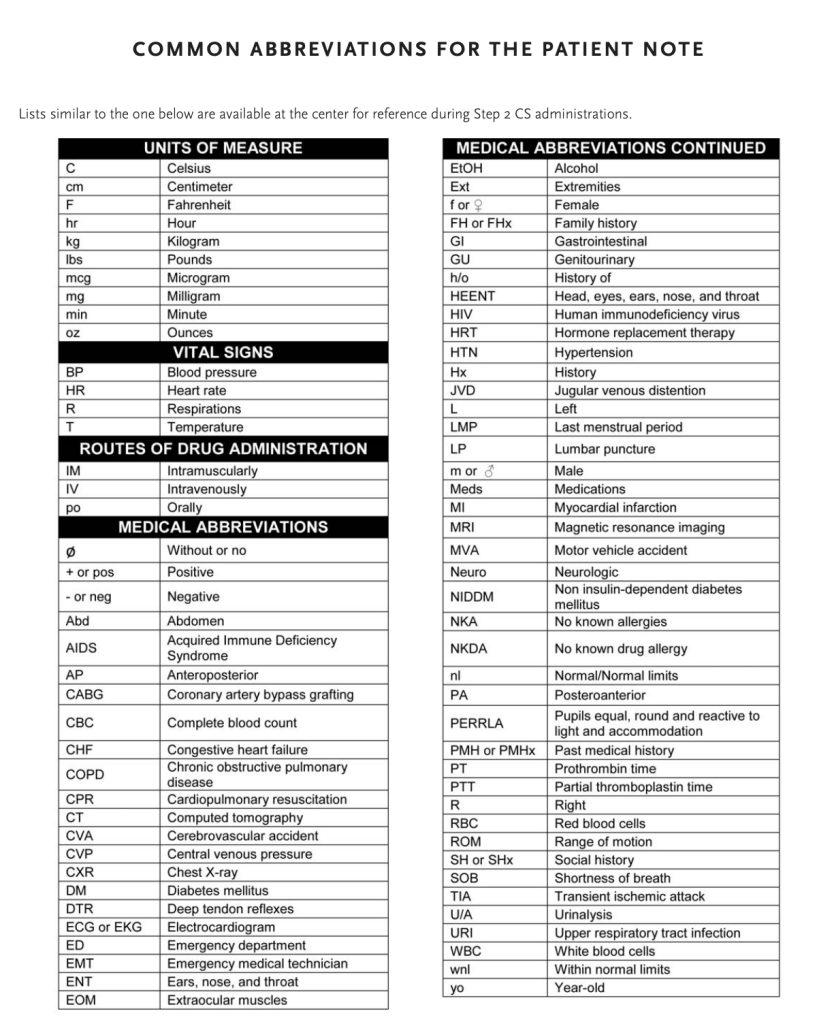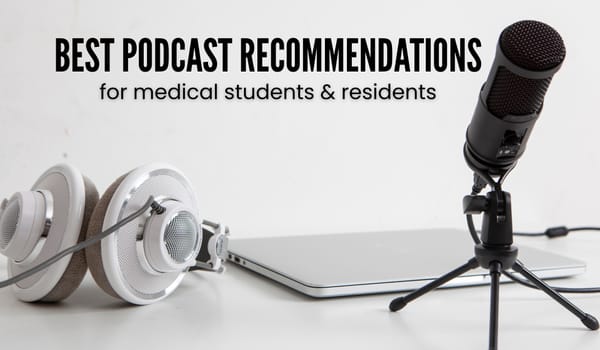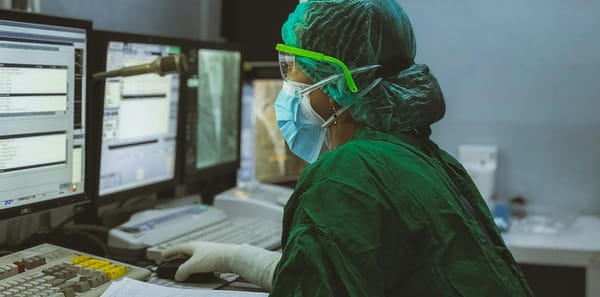Step 2 CK and CS: My Plan of Attack
I’ve finished Step 1 and although I’m not thrilled with how it went (click here to read…
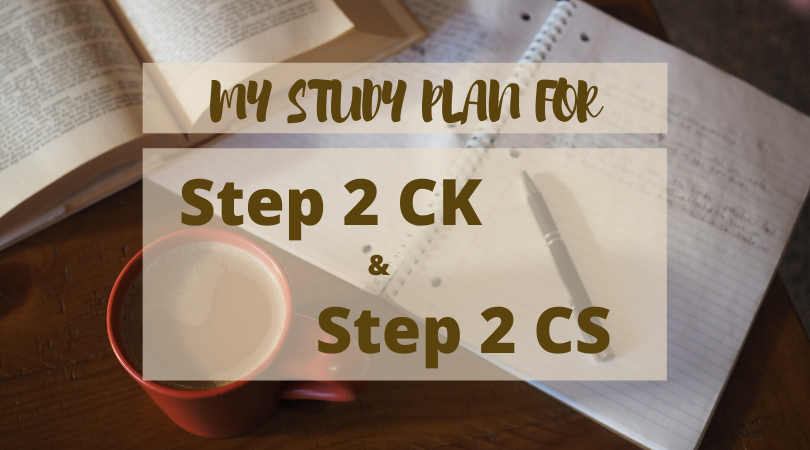
I’ve finished Step 1 and although I’m not thrilled with how it went (click here to read my score reveal), it is what it is. Life goes on, and the standardized testing never ends so… yay! (?)
To be able to qualify for residency (physician training) in the United States, you have to complete three exams: Step 1 and Step 2 (which is split into two big exams, called CK and Step 2 CS). Read on to learn a bit about them both, and then I’ll talk about how I’m approaching them.
Proposed Test Dates
I get a lot of questions about when I’ll be taking these exams, so let me just get that out of the way.
- Step 2 CK: I plan to take the exam sometime at the end of August at the earliest, but before September 25th at the latest (which is when I would be starting a rotation in the US, if all goes well).
- Step 2 CS: I hope to take it after my rotation ends, so around January. I’m hoping that with hands-on experience in the US, I can plug whatever I’d missed during my med school studies.
And now, keep reading to learn more about Step 2 CK and CS, and how I’ll be studying for them!
Step 2 CK:
What is CK?
CK stands for Clinical Knowledge – this is an exam that aims to test our theoretical knowledge before we become full-fledged doctors. The focus is much more on the diagnostic and treatment algorithms that Step 1 was, and it is geared toward preparing us for what we would see in our own hospitals/clinics.
Here’s a comparison, taken directly from usmle.org. (Actually, it’s interesting to note that the %’s of what’s covered on which test is changing for Step 1 after May 4th, so check the website for more information if that’s relevant for you.)

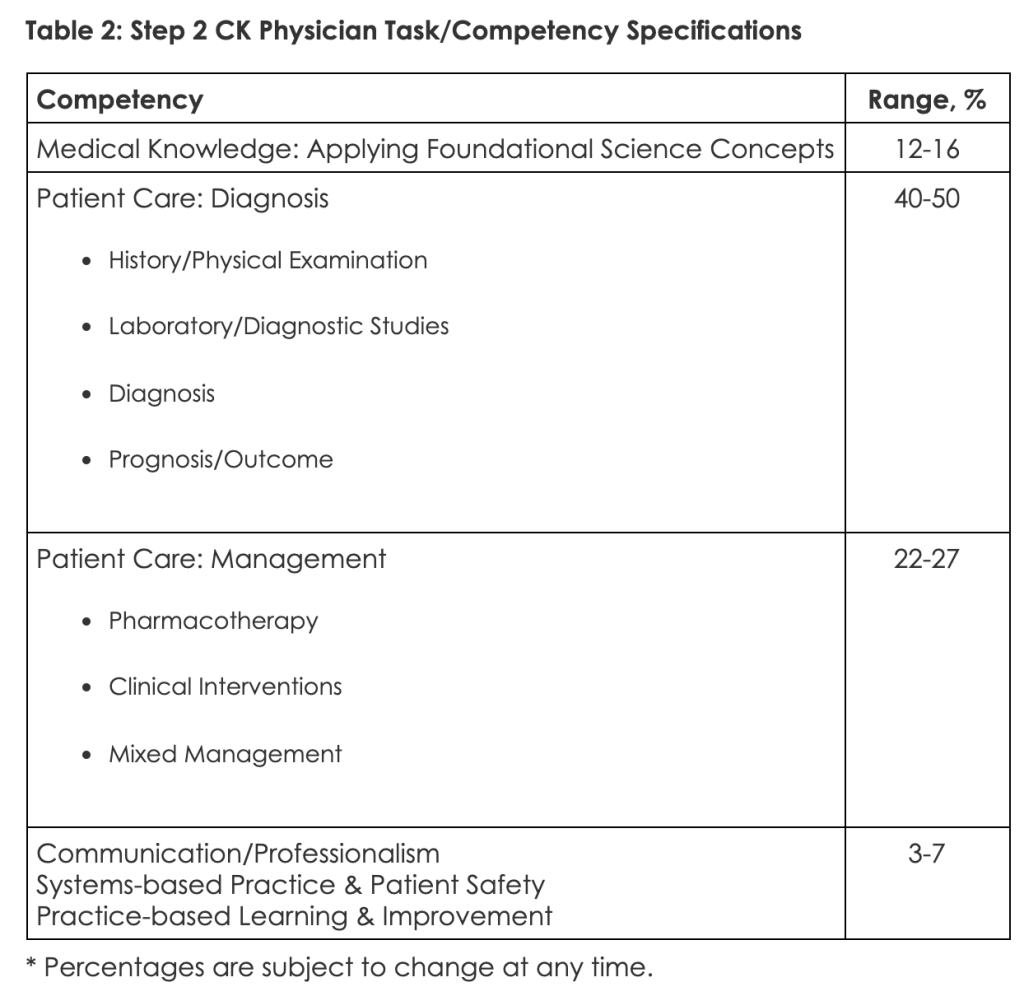
As you can see, the focus for CK is much more on patient care: diagnosis, management, prognosis, etc. A lot of people say that Step 2 CK is a much ‘easier’ exam than Step 1, because it requires us to learn things that are relevant and useful in the wards.
How I’m Approaching It
The resources for Step 2 are not as numerous as they are for Step 1, and many people didn’t use too much resources. I’ll try to do the same, so below I’ll explain the key things:
STEP UP TO CK (textbook)
I got it from Amazon when I was in the States. I used the Step Up to Medicine for my clinical classes in 4th year and I really liked the textbook, and when my friend recommended it for CK, I thought, “Why not?”
There’s no consensus on a “Bible” of CK, as there was for Step 1. First Aid (FA) for CK is not that good – in my opinion, when I tried it out last year, I really didn’t like the format/the layout. Since SUTCK appealed to me more, that’s what I decided to go with.
Feedback: it’s a good book, it covers a lot of what’s on the exam; however, it doesn’t have everything. UW will still be my #1 source, and at first I was annotating things into the book from Amboss/UW, but I quickly realized that that’s inefficient. There’s too much that’s not covered and it would take too long; furthermore, I don’t like rereading books (I learned that with FA from Step 1). So now I use it more as a, “Read through once to get a general idea,” and I’ll make my own notes based off UW similar to my Step 1 Notes (linked here).
I like their “Quick Hit” feature (where they mention important clinical tidbits in the margins), and I love the layout/format. One thing I don’t like is that they don’t emphasize *best* treatment, or *main* diagnostic step, like Dusty does in OME; they simply list ALL the relevant things, and it’ll be up to the UW questions to teach me what’s the best to use.
STEP 2 SECRETS (book)
One of my favorite YouTube channels, DIRTY USMLE (he makes great videos for Step 1) recommended this book. I know you don’t technically need two books, but I value his opinion and SUTCK and the Secrets book are very different. Step 2 Secrets is organized in a Q&A format, and I mostly use it when I’m in class (and the lecture is useless), or I have a half hour to kill before my next appointment.
OnlineMedEd (free videos and paid Qbank)
OME has FREE videos that cover most clinical subjects. They’re rudimentary, and serve as an introduction to the ‘wards and the boards.’
I used OME a bit for my clinical classes and I loved it – the lecturer has an incredible way of simplifying what we need to know, and he explains concepts so that they become logical. This means that there’s less to memorize, which is always a blessing.
Although the videos are free, the notes and question bank of approximately 1200 questions isn’t; I have premium, which allows me to download videos/audio for offline studying (great for when the wifi stops working), and I’ll tackle the qbank at some point too.
For $80 off your purchase of Premium, click here!
UWorld (absolute must)
This goes without saying – UWorld remains the gold standard for these exams. I just purchased a 1-year subscription (I didn’t want to make the same mistake as for Step 1, where I had to extend it by just a few weeks for a ton of money). I’ll do two passes of UW, like last time, but this time I’m started in RANDOM, TIMED MODE from Day 1.
(I wish I had a discount code for UWorld, but sadly, I don’t.)
Amboss
This online learning platform has two parts: their ‘knowledge library’ and their question bank. I have a subscription to both because I absolutely love the program.
The Knowledge Library serves as a great reference for things that I feel especially weak on – for example, I struggle with Obstetrics, so I can read through their learning cards related to OB and it helps me make sense of everything. They’re very logically laid out, and they have a HIGHLIGHT tool that shows what’s high yield for Step 2.
Their Qbank is challenging – they have some tough questions, and I get consistently bad scores on my blocks of Amboss questions. It doesn’t bother me though, because I am using it merely as a learning tool. I don’t take Amboss questions as seriously as I do UWorld (meaning that if a disease sounds strange or a presentation is very unusual and only 12% of people got the question right, I might not make notes on it). But it helps hammer home key points and gets me extra practice, which never hurts.
I also love their image annotations: by using the ‘overlay’ feature, I can see exactly what I’m meant to be noticing on histology and radiology images, and this tool is honestly priceless.
For a two week free trial, click here!
For 10% off your purchase, click here!
NEW RESOURCE ADDITION: uWISE
My friend came across uWISE, a university-made mini-qbank for just OBGYN. Since obstetrics and gynecology is a really tough subject (and I guess not just for me), students opt to purchase this extra 500 questions to get more practice.
“UWise is a 529-question interactive self-exam helps medical students acquire the necessary basic knowledge in obstetrics and gynecology, regardless of future medical specialty choice.”
– from the website
I haven’t purchased it yet, but I likely will after my first pass of UWorld. I’m only a few hundred questions into it, and I’m already struggling so much with OBGYN.
Step 2 CS:
What is it?
This exam is all about Clinical Skills – the practical part of being a doctor. Doctor-patient communication, physical examination and thinking on the spot. This exam is unlike any other I’ve taken before: you are given 12 Standardized Patients (who are highly skilled actors instructed on how to portray different disease presentations) and you have to take the history, do a focused physical and write up your medical analysis (differential diagnosis, next steps, etc.) note in an American format.
CS is challenging for IMGs (international medical graduates) because our clinical experience is different – we learn slightly different ways to palpate, percuss, even auscultate. Most of us have limited exposure to US clinical settings and most of us have never written a ‘note’ in the US format. Not to mention, your every movement is being watched and graded over a span of 8+ hours.
It’s a very nerve-wracking experience, and although the test is pass/fail, it’s not as hard to fail as you might think.
Things to Know
This exam is only available in five locations worldwide: Houston, Chicago, Philadelphia, Atlanta and… LA? Yes, Los Angeles.
This exam fills up FAST. You have to book months in advance, and the scoring takes ages. Here’s a screenshot of the score reporting schedule for 2020, just to give you an idea of the extent of the delay.
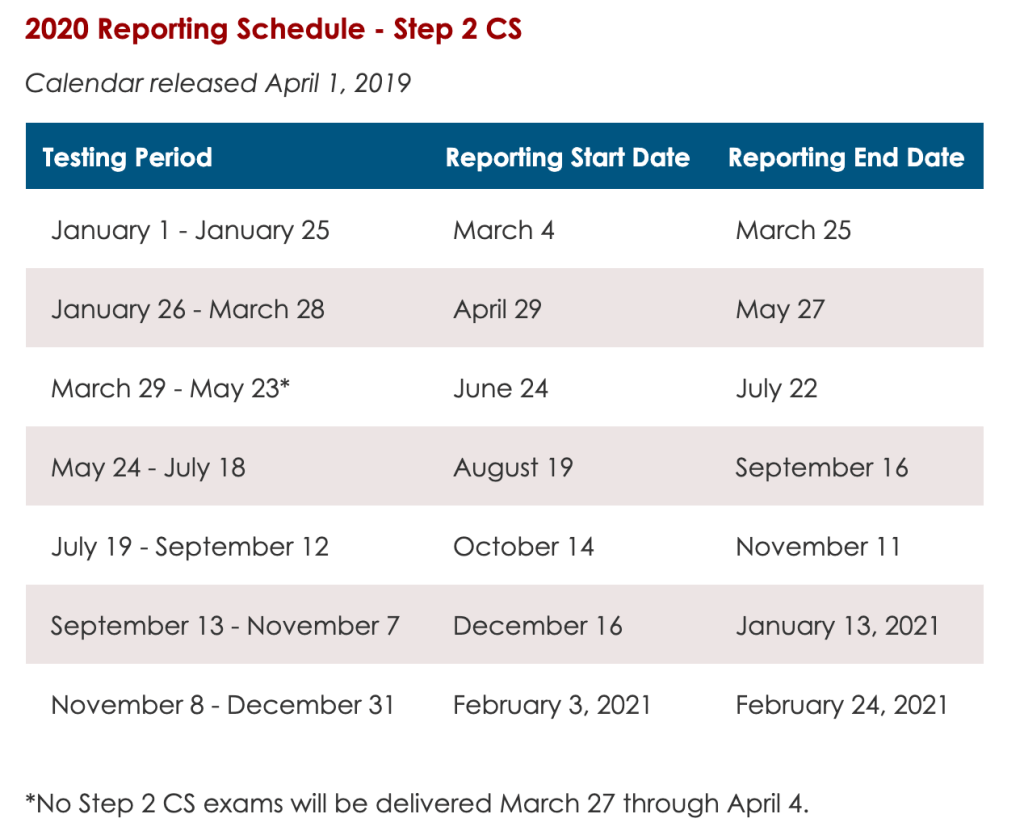
How to Study For It
Since this exam is different than any other exam I’ve taken, the study approach must also be different – I just don’t know how. But let’s start at the beginning:
USMLE.org
My first thought was to go to the source, so I downloaded the Step 2 CS pamphlet from usmle.org to get some information about this exam from the makers of the test. I highly recommend reading through this to ALL people preparing for CS. It’s really well written and gives excellent insight into the common pitfalls of the exam. Read it! 🙂
Linked here for your convenience, the Step 2 CS Information Manual!
First Aid CS
Unlike for Step 2 CK, the First Aid textbook for CS comes highly recommended and I agree that it’s EXCELLENT. Besides outlining exactly how to approach each aspect of the exam, it gives case presentations in the back that are MADE FOR studying with a partner (more on that below).
Prep Courses
There are online and LIVE preparatory courses in the US, and my good friend did one of the (with USMLE Success Academy). They’re quite expensive so I’m not sure that I’ll be able to do one, but she spoke very highly of her experience with USMLE Success Academy in Chicago.
Would you be interested in a giveaway for a 1-Day Mock Exam with USMLE Success Academy? Comment below so I know whether to host such a giveaway or not!
YouTube Videos
Like with everything else, there’s lots of free information online, and as I come across handy YouTube videos for Step 2 prep, I’ll share it here.
Studying with a Study Partner
Now for the meat of this post: how I’m studying with a study partner. Getting live practice in is the #1 way to study for such an exam (I believe, and others have said the same thing as well).
You can read 100 times that you need to wash your hands, but when you’re there, in front of the patient, on exam day, stressed and anxious, you can easily forget to do it…and potentially fail? That would be a shame. So the key is to drill the basic things so hard that you wouldn’t forget them in a million years.
My study partner (SP) and I will meet approximately once a week and go over a few cases together. She has a list of great mnemonics, and we’re both studying them in the interim to make our time together as useful as possible.
- One of us is the ‘patient’ and the other is the ‘doctor.’ Let’s say I’m the patient.
- We start a timer: on the exam, you have 15 minutes, so we want to emulate that as closely as possible.
- We pick a case from FA CS – I choose one and show her the ‘doorway information,’ which is what we get to see at the exam itself.
- She has a sheet of paper and she sits and writes down her quick thoughts/mnemonics onto a sheet of paper; during this time, I ‘study’ my case as fast as possible.
- FA is incredible because it tells the SP how to act. It says things like, “If doctor mentions sputum, ask, ‘What is sputum?’,” it instructs you to absentmindedly scratch your arms (from the itchiness secondary to your jaundice), and it prompts you with ‘difficult questions’ to ask when the doctor says, “Do you have any questions for me?” at the end.
Simulating the History/Physical
- She goes through her history taking, and I peek at FA to give as accurate answers as possible. Here, it’s important to take it seriously and not giggle all the time (although we found ourselves laughing and looking confused for sure!)
- for my first case, I completely and totally forgot to ‘wash my hands.’ Like I said – it’s so easy to forget in the moment, and this is not something I want to fail on. So that’s why we practice.
- For the physical, we try to make that as realistic as possible. We do auscultate over the clothes, but we also take the time to ‘listen’ as long as we would on the real exam. It’s important to get a sense of the time constraints.
- in the future, we’ll practice things like ‘draping the patient respectfully,’ etc. so that it all becomes second nature. But for now, we’re just getting started.
- She does her concluding spiel, and ‘exits.’
- Then we grade her performance: I use the checklist provided in FA to check off the things she asked, and we discuss the differential diagnoses that she would put on her note. We give feedback, and I think both of us can learn from that.
- in the future, I think we’ll both practice writing a note after each case, and compare to each other and the book as well. Practice makes perfect!
- Then we switch! In each meeting, we’ll likely do 2 cases each (so at 15 mins/case, that would take us a bit more than hour, maybe an hour and a half with discussion).
The Potential Difficulties:
- Timing: her exam is much earlier than mine, which isn’t ideal but what can you do
- Distance: a lot of people look for online partners – I would argue this isn’t as good, and I encourage you to look in your immediate area. Being in the room with a patient and doing a physical examination is honestly so different than pretending to do one over the phone.
Resources for Step 2 CS
HPI Blue Sheet: the incredible @spooky.doctor sent me this PDF. It has a really handy outline of how to do a history in a format that will make it easy to transition it to the ‘note’.
Mnemonics and videos: the same website that gave us the Blue Sheet has a ton of handy resources, including an extensive list of mnemonics and videos. Surf this website to your heart’s content – it has a lot of hidden gems!
Example videos from usmle.org: if you’re having trouble picturing this exam, this video is great because it’s straight from the source – the people who hire and train the actors!
Patient Note Entry Form for Practice: also from usmle.org; this program emulates the note program that you’ll be facing on test day.
List of Abbreviations: a comprehensive list of what you can use in your note – this will be available at the testing center too! This list is from the CS manual, linked here.
